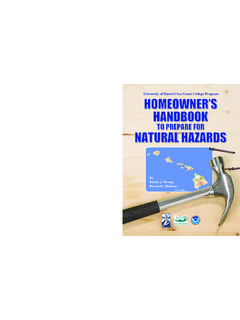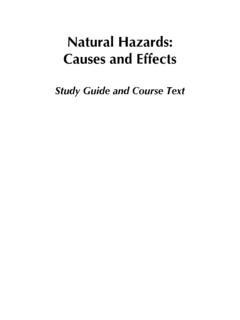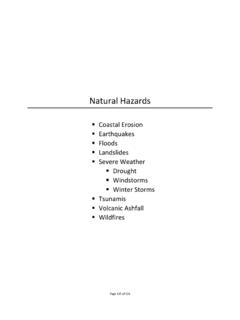Transcription of E36. Natural hazards and flooding - Auckland Council
1 E36 Natural hazards and flooding Auckland Unitary Plan Operative in part 1 E36. Natural hazards and flooding Background Auckland is affected by Natural hazards including: those that occur frequently such as flooding , coastal erosion (including the effects of sea level rise), freshwater erosion and land instability; and those that occur less frequently such as wildfires, volcanic activity, tsunami, earthquakes and meteorological hazards such as cyclones, tornados and drought. All of these hazards can affect people, property and the wider environment. The risk that these Natural hazards pose is made up of factors including: the nature, magnitude and extent of the hazard; the anticipated frequency or probability of the hazard event occurring; and the exposure and vulnerability of the environment to the hazard. Decisions on how to avoid or mitigate Natural hazards can affect not only the subject site but also neighbouring properties and the wider environment, and may unintentionally exacerbate the risk.
2 Risk assessment is a key means to identify and understand risks, and to determine which aspects of risk can be managed through appropriate land use planning tools and development methods. Both current and future risks (including the effects of climate change such as sea level rise) need to be considered. A flexible risk-based approach has been taken to address the risks associated with Natural hazards . A risk management approach applies to existing development and infrastructure while a risk reduction (including avoidance where appropriate) approach applies to development of greenfield land. The Plan has defined criteria to identify land which may be subject to Natural hazards . The Plan requires the use of the best information available to identify greenfield land or land which is proposed for redevelopment which may be subject to Natural hazards .
3 This includes hazard maps, databases and reports held by the Council . The level of detail and the quality of this information is variable. This affects the Council s ability to identify and map land that may be subject to Natural hazards . At this time, the provisions in the Plan are focussed on the following hazards : coastal erosion; coastal storm inundation; flooding ; land instability; and wildfires. The Council is working to gather, assess and refine information so that a more comprehensive range of Natural hazards can be assessed and, as appropriate, subdivision, use and development can be better managed through provisions in the Plan. E36 Natural hazards and flooding Auckland Unitary Plan Operative in part 2 Some risks from events with low probability but high potential impact ( volcanic activity, tsunamis and earthquakes) cannot be addressed through land use planning and may be better addressed through measures put in place by emergency management groups such as Civil Defence.
4 These include education, warning systems and emergency preparedness. Objectives (1) Subdivision, use and development outside urban areas does not occur unless the risk of adverse effects to people, property, infrastructure and the environment from Natural hazards has been assessed and significant adverse effects are avoided, taking into account the likely long-term effects of climate change. (2) Subdivision, use and development, including redevelopment in urban areas, only occurs where the risks of adverse effects from Natural hazards to people, buildings, infrastructure and the environment are not increased overall and where practicable are reduced, taking into account the likely long term effects of climate change. (3) Subdivision, use and development on rural land for rural uses is managed to ensure that the risks of adverse effects from Natural hazards are not increased and where practicable are reduced.
5 (4) Where infrastructure has a functional or operational need to locate in a Natural hazard area, the risk of adverse effects to other people, property, and the environment shall be assessed and significant adverse effects are sought first to be avoided or, if avoidance is not able to be totally achieved, the residual effects are otherwise mitigated to the extent practicable. (5) Subdivision, use and development including redevelopment, is managed to safely maintain the conveyance function of floodplains and overland flow paths. (6) Where appropriate, Natural features and buffers are used in preference to hard protection structures to manage Natural hazards . Policies General (1) Identify land that may be subject to Natural hazards , taking into account the likely effects of climate change, including all of the following: (a) coastal hazards (including coastal erosion and coastal storm inundation, excluding tsunami); (b) flood hazards ; (c) land instability; and E36 Natural hazards and flooding Auckland Unitary Plan Operative in part 3 (d) wildfires.
6 (2) Investigate other Natural hazards to assess whether risks to people, property or the environment should be managed through the Plan or otherwise. (3) Consider all of the following, as part of a risk assessment of proposals to subdivide, use or develop land that is subject to Natural hazards : (a) the type, frequency and scale of the Natural hazard and whether adverse effects on the development will be temporary or permanent; (b) the type of activity being undertaken and its vulnerability to Natural hazard events; (c) the consequences of a Natural hazard event in relation to the proposed activity; (d) the potential effects on public safety and other property; (e) any exacerbation of an existing Natural hazard risk or the emergence of Natural hazard risks that previously were not present at the location; (f) whether any building, structure or activity located on land subject to Natural hazards near the coast can be relocated in the event of severe coastal erosion, inundation or shoreline retreat; (g) the ability to use non-structural solutions, such as planting or the retention or enhancement of Natural landform buffers to avoid, remedy or mitigate hazards , rather than hard protection structures; (h) the design and construction of buildings and structures to mitigate the effects of Natural hazards ; (i) the effect of structures used to mitigate hazards on landscape values and public access; (j) site layout and management to avoid or mitigate the adverse effects of Natural hazards , including access and exit during a Natural hazard event.
7 And (k) the duration of consent and how this may limit the exposure for more or less vulnerable activities to the effects of Natural hazards including the likely effects of climate change. (4) Control subdivision, use and development of land that is subject to Natural hazards so that the proposed activity does not increase, and where practicable reduces, risk associated with all of the following adverse effects: (a) accelerating or exacerbating the Natural hazard and/or its potential impacts; (b) exposing vulnerable activities to the adverse effects of Natural hazards ; E36 Natural hazards and flooding Auckland Unitary Plan Operative in part 4 (c) creating a risk to human life; and (d) increasing the Natural hazard risk to neighbouring properties or infrastructure. Coastal hazards (including coastal erosion and coastal storm inundation) (5) Ensure that subdivision, use and development on rural land for rural uses and in existing urban areas subject to coastal hazards avoids or mitigates adverse effects resulting from coastal storm inundation, coastal erosion and sea level rise of 1m through location, design and management.
8 (6) Avoid subdivision, use and development in greenfield areas which would result in an increased risk of adverse effects from coastal hazards , taking account of a longer term rise in sea level. (7) Ensure that buildings in areas subject to coastal hazards are located and designed to minimise the need for hard protection structures. (8) Ensure that when locating any new infrastructure in areas potentially subject to coastal hazards consider, where appropriate, an adaptive management response taking account of a longer term rise in sea level. (9) Require habitable areas of new buildings and substantial additions, alterations, modifications or extensions to existing buildings located in coastal storm inundation areas to be above the 1 per cent annual exceedance probability (AEP) coastal storm inundation event including an additional sea level rise of 1m.
9 Defences against coastal hazards (10) Avoid the modification, alteration or removal of sand dunes and vegetation on sand dunes which would compromise their function as Natural defences for an area subject to coastal hazards and ensure adverse effects on wider coastal processes are avoided or mitigated. (11) Consider hard protection works to protect development only where existing Natural features will not provide protection from the Natural hazard and enhancement of Natural defences is not practicable. (12) Require hard protection works involving the placement of any material, objects or structures in or on any area located above mean high water springs to be designed and located to avoid, remedy or mitigate adverse environmental effects including all of the following: (a) location of structures as far landward as possible to retain as much Natural beach buffer as possible; (b) any likely increase in the coastal hazard, including increased rates of erosion, accretion, subsidence or slippage; (c) undermining of the foundations at the base of the structure; E36 Natural hazards and flooding Auckland Unitary Plan Operative in part 5 (d) erosion in front of, behind or around the ends or down-drift of the structure; (e) settlement or loss of foundation material; (f) movement or dislodgement of individual structural elements.
10 (g) offshore or long-shore loss of sediment from the immediate vicinity; (h) long-term adverse visual effects on coastal landscape and amenity values; and (i) effects on public access. Floodplains in urban areas (13) In existing urban areas require new buildings designed to accommodate more vulnerable activities to be located: (a) outside of the 1 per cent annual exceedance probability (AEP) floodplain; or (b) within or above the 1 per cent annual exceedance probability (AEP) floodplain where safe evacuation routes or refuges are provided. (14) Require redevelopment of sites where existing more vulnerable activities are located within the 1 per cent annual exceedance probability (AEP) floodplain to address all of the following: (a) minimise risks from flood hazards within the site; (b) minimise the risks from flood hazards to people and property upstream and downstream of the site; (c) remedy or mitigate where practicable or contribute to remedying or mitigating flood hazards in the 1 per cent annual exceedance probability floodplain; (d) location of habitable rooms above flood levels; and (e) provide safe evacuation routes or refuges from buildings and sites.
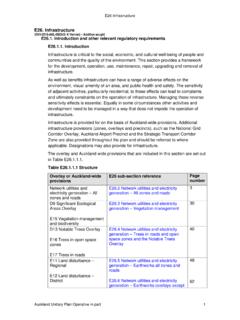

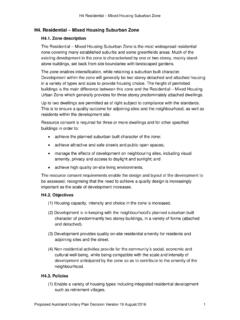
![[CIV-2016-404-002333: Franco Belgiorno-Nettis] …](/cache/preview/5/c/8/9/4/8/0/b/thumb-5c89480b05b74af8de3dfd881b8f281a.jpg)




![J1. Definitions [rps/rcp/rp/dp] - Auckland Council](/cache/preview/d/d/2/a/0/8/d/0/thumb-dd2a08d06e371f3ed80cf4e9fa2dd563.jpg)



